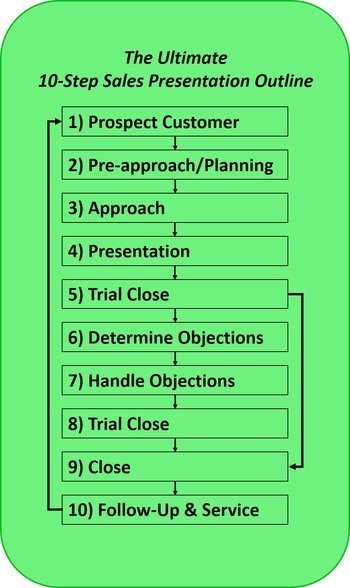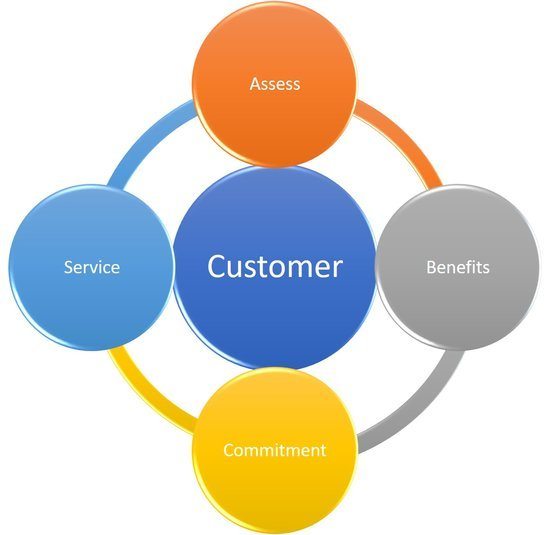10-Steps to Your Ultimate Sales Presentation (with Examples)
One of the first things every new salesperson needs to learn, if they are to succeed, is how to develop and deliver a sales presentation. A lot of factors go into developing a sales presentation for a specific situation. However, by following a logical series of steps, it will greatly enhance the chance of making a sale.
A sales presentation is defined as “a talk giving information about a product or service that you are trying to sell, intended to persuade people to buy it.” Historically, sales presentations were delivered one-on-one with the salesperson, presenting directly to a buyer.
However, technology has expanded the traditional in-person sales presentation to include the potential for video conference presentations, telephone presentations, presentations delivered via email, and even long-form presentations delivered via internet web sales pages.
Regardless of the delivery method, a salesperson who follows a logical series of steps will have the greatest chance of making a sale.
The graphic below depicts an outline of the Ultimate 10-Step Sales Presentation:

Each step of the Ultimate Sales Presentation is important and contributes to the likelihood of making a sale. That said, not every step is needed in every selling situation. Sometimes the buyer is ready to buy after Step 4: Presentation. Sometimes the buyer will inject objections immediately as the salesperson begins, Step 3: Approach.
As I said, every salesperson/buyer interaction is different. The relational salesperson is acutely aware of this difference and will flex their presentation to meet the needs of the buyer.
10-Step Ultimate Sales Presentation
So now, let’s take a quick look at each of the 10-Steps of the Ultimate Sales Presentation.
1. Prospecting
Prospecting is the first step in the selling process. A prospect is a buyer who has the potential to buy your product or service. A lead is not the same thing as a prospect! A lead is simply someone for whom the salesperson has contact information. Once the lead has been qualified, they then become a prospect.
A lead becomes a qualified prospect when they exhibit these three characteristics:
- They must have the money to buy.
- They must have the authority to buy.
- They must have a desire to buy.
Prospecting is the lifeblood of many sales roles. Keeping a pipeline full of potential prospects is critical in industries like real estate, insurance, and vehicle sales. Even many retail businesses (like department stores) rely on prospecting to develop new customers.
2. Pre-approach/Planning
Planning is the second step in the selling process. Planning is done after we have identified a qualified prospect, and before we approach the customer.
A plan is a sales presentation strategy designed to achieve a specific end goal. A plan describes what you want to achieve and how you will do it.
The desire of a relational salesperson is to help people. The purpose of meeting with a buyer is to help that person in some way. The purpose of the plan you create is to help the person by selling the right product or service to meet their needs.
Planning is critical to the sales process because it accomplishes four things:
- Planning builds the confidence of the salesperson.
- Planning demonstrates the salesperson’s professionalism.
- Planning often builds goodwill between the salesperson and the buyer because the buyer sees the effort taken by the salesperson to meet their needs.
- Planning increases the probability of making the sale because the salesperson better understands the buyer’s needs.
3. Approach
The approach is the third step in the selling process. It is the period of time between when the salesperson first sees the buyer up until they start to discuss the product. The approach is the first step of the actual sales presentation.
The approach step of the sale presentation process consists of two distinct, yet equally important, parts. First is the rapport building, “small talk.” This is usually the first minute or two of the sales meeting where the salesperson might talk about something you know the buyer is interested in (sports, weather, family, children, etc.).
The second part of the approach step is the planned, formal lead-in to the actual discussion of the product.
The main thing every buyer wants to know is whether the product you’re about to discuss will meet their needs. As a salesperson, your approach to lead-in to the presentation with the buyer must accomplish three things:
- You must capture the buyer’s attention.
- You must stimulate their interest in your product or solution.
- You must then transition smoothly into the presentation.
The approach lead-in might take the form of a statement, a question, or a demonstration. Whichever method you choose (statement, question, or demonstration), you must capture the buyer’s attention, stimulate their interest in the product, and transition into the main body of the presentation.
Approach Example
An example of the statement/question approach is, “What a wonderful picture of your two children! How old are they?… That’s a wonderful age. Mrs. Buyer, the reason I wanted to meet with you today is I have an idea that I think will increase your sales and profit. Is that something you are interested in?”
As soon as you have the buyer’s attention and gained their interest, it’s time to transition directly to the main body of your presentation.
4. Presentation
The presentation is the fourth step in the selling process. The presentation is your persuasive verbal and visual explanation of your selling proposition. The presentation follows the approach.
The presentation takes the buyer through five distinct stages in the buying cycle that build upon one another:
- To provide knowledge in the form of features, advantages, and benefits so that the buyer can make an informed decision.
- This knowledge translates into positive beliefs about you and your product/service.
- The positive beliefs result in the buyer having a desire for the product.
- The desire for the product becomes an attitude that your product is the best product to fulfill the buyer’s need.
- When the buyer realizes you have the best product to meet their needs, they move into the conviction stage. They are now convinced yours is the product they need to buy.
Once the buyer has reached the conviction stage, it is time for a trial close.
5. Trial Close
A trial close is the fifth step in the selling process. The trial close is not asking the buyer to decide to buy. Rather, the trial close asks for the buyer’s opinion regarding what they have heard so far.
The trial close allows the salesperson to determine:
- Whether the buyer likes your product or service.
- Whether you have successfully answered any questions from the buyer.
- Whether any additional questions remain unanswered.
- Whether the buyer is ready for you to close the sale.
The trial close is an important yet often underutilized tool. A trial close can be used:
- After making a significant point in the presentation.
- After answering any questions or objections from the buyer.
- After the close of the main body of the presentation, and before you move to close the sale.
Trial Close Examples
Examples of a simple trial close include,
- “Does that answer your question?”
- “How does that sound to you?”
- “What do you think about what we’ve discussed so far?”
If the trial close results in a positive response from the buyer, jump to Step 9: Close. However, most trial closes will result in some questions or objections from the buyer. It’s time to determine and handle objections.
6. Determine Objections
Determining objections is the sixth step in the selling process. Assuming the trial close has resulted in questions or objections from the buyer, we now must begin the process of discovering those questions and handling those objections.
Some salespeople bristle and get defensive when asked questions or confronted with objections from a buyer. But this is the wrong way to think about objections! Salespeople should be grateful for questions and objections because they indicate the buyer’s interest. They also help the salesperson determine which stage of the buying cycle the buyer is in—attention, interest, desire, or conviction.
If the buyer has raised an objection, the salesperson needs to ensure their understanding of the objection. One easy way to do that is to restate the objection and ask for confirmation.
Determine Objection Example
For example, if the buyer has raised an objection about the expected life of a machine, the salesperson might say, “If I understand you correctly, your main concern with this machine is that it will provide you with trouble-free service for several years. Is that right?”
When the buyer confirms your understanding of the objection its time to move to the next step in the selling process and handle the objection!
7. Handle Objections
Meeting or handling objections is the seventh step in the selling process. Once you have determined you understand the buyer’s objection, you need to handle the objection. Usually, objections should be handled as soon as they are brought up. However, you may want to delay handling the objection if you are just about to talk about the question in your presentation.
There are four important points to consider when handling objections:
- Handle objections when they arise.
- Be positive when responding to objections.
- Listen carefully to the buyer as they state their objection.
- Confirm your understanding of the objection.
Some objections are false, and these can usually be ignored. However, if a buyer brings up an objection a second time, it is most likely a real issue, which needs to be addressed.
Real objections are almost always a request for more information. So, the best way to handle them is to answer the question with the specific relevant information the buyer needs.
Handle Objection Example
Going back to our machine question in the Determine Objection section above, the salesperson might continue, saying, “I certainly understand your concern. Our company has placed over 300 of these machines in companies like yours over the past ten years, and I’m proud to say they have a 99% run rate with no failures!
8. Trial Close
A follow-up trial close is the eighth step in the selling process. Whenever a question or objection is raised and handled, it’s time to try a trial close. As before, the point of the trial close is to ensure you have answered the buyer’s question to their satisfaction. If there is any doubt that the buyer is satisfied with your answer, you need to dig in to discover what other issues the buyer might have.
Trial Close Example
In our machine example, the salesperson might simply say, “Does our machine’s long life and 99% run rate answer your concern for our product’s reliability?”
When the salesperson feels that all the questions and objections have been addressed satisfactorily, it’s time to move on to the Close!
9. Close
The close is the ninth step in the selling process. Closing is simply the process of helping the buyer make a decision that benefits them. The salesperson should attempt to close the sale when they feel the buyer is in the Conviction stage of the buying process.
Unfortunately, research shows a whopping 64% of salespeople fail to close. They fail to ask for the order! There are several reasons why this is the case, but generally, most of them revert to fear. The salesperson is afraid of failure, of being told “no.” Whereas, relational salespeople who are selling to solve problems and help people should never be afraid to ask for the order!
Good closers plan the close of their sale as carefully as they plan all the rest of their presentation. The close is not something you tack on to the end of the presentation, hoping that the buyer will say “yes.”
Close Example
There are many ways to close, but the simplest way is just to ask for the order and stop talking.
A salesperson might say, “Mr. Buyer, we’ve covered a lot of ground today, and I think you agree this machine will increase your production and improve your sales and profit. I have the order contract ready for your signature.” Then stop talking!
Another form of the close that I personally like is the assumptive option close. The salesperson might say, “Mr. Buyer, we’ve covered a lot of ground today, and I think you agree this machine will increase your production and improve your sales and profit. Would you like to have it delivered and installed next week, or would the following week be better for you?”
10. Follow-Up and Service
Finally, follow-up and service after the sale is the tenth step in the selling process. Sales are not about you. It’s about you taking care of your customers, and that happens after the buyer says “yes.”
What you do after the sale to provide follow-up and service to the customer is critical. It makes the difference between making a sale to a customer one time and making a sale to the same loyal customer many times year after year!
A salesperson who is diligent about providing follow-up and service after the sale will outperform the salesperson who does not perform that service. This maxim holds true simply because it is always easier to sell more to a current happy customer than find new customers. Happy, satisfied customers tell others and provide a flow of new business leads to the salesperson.
There are six steps the salesperson should take after the sale:
- Focus on improving account penetration. Get to know as many people in the account as you can. Look for needs or problems that you might be able to solve.
- Continue regular contact with the customer. Make sure every promise made in the presentation is kept.
- Handle any issues or customer complaints immediately. Things will go wrong, and the speed at which you handle even a minor issue demonstrates your commitment to the customer.
- Always keep your promises. Nothing destroys a developing relationship, like not keeping your promises. Stay true to your word. The customer placed their faith in you when they bought your product. You need to respect that faith by keeping your word.
- Become the customer’s business advisor. Do what you can to shift from the role of the salesperson to that of the trusted advisor by providing helpful industry insights, new information, or problem-solving solutions. Become a valued partner in the business!
- Show your appreciation. Showing your appreciation is a simple way to demonstrate you are thinking about the customer. Never underestimate how much a handwritten thank-you note, a congratulatory phone call, or a birthday card will mean to a buyer!
There you have it, a quick overview of the Ultimate 10-Step Sales Presentation Model!
The Ultimate 10-Step Sales Presentation Series
I hope what I shared with you here has helped you understand and appreciate the power of the Ultimate 10-Step Sales Presentation model. But I’ve just scratched this surface here! Over the next few months, I’ll be sharing more detail about each step of the model with more examples.
If you want to learn more about the Ultimate 10-Step Sales Presentation model, you can subscribe to the series here. That way you won’t miss any of this valuable information!
Join the Conversation
As always, questions and comments are welcome. What questions do you have about the Ultimate 10-Step Sales Presentation model? Are there any steps you think are more or less important than others?
I’d love your help. This blog is read primarily because of people like you who share it with friends. Would you be kind enough to share it by pressing the share button?
Category: Salespeople















